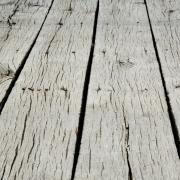How to Tell if You Need to Replace Your Deck
Decks get a lot of wear and tear from being out in the elements year round. When this deterioration becomes serious, it’s time to consider replacing your old deck.
Wood, especially pressure-treated wood, doesn’t have a long lifespan. Rot is a common problem, and can weaken the entire structure of your deck.
Water Damage
If your deck has been damaged by water, you may want to consider replacing it. Whether the water damage comes from plumbing, roof leaks, overflowing appliances, a clogged toilet or a flood, it can have long-term impacts on your home.
You might be able to tell that your deck needs to be replaced if you find sagging boards or a platform that wobbles when you step out on it. This is a sign of foundation issues and could indicate that the concrete anchors or footings that hold the posts are weak and can no longer support the deck.
Ledger flashing helps prevent moisture from getting between the ledger board and the house. If the flashing isn’t in good shape, you might notice water seeping between the house and deck. This can lead to rot and mold growth that can be a serious safety hazard. Moreover, the wood that is rotting could also be in danger of collapsing and falling off the deck.
Loose Railings
Loose railings are a major safety hazard, as they can collapse when people lean on them. This can lead to serious injury or death, so it’s best to repair your railings right away!
If your deck railings are loose, make sure to check the screws and bolts that anchor them in your joists. These may be rusted or cracked from weather exposure.
When this happens, it’s time to replace the screws and bolts that are holding them in place. This will prevent future problems.
The Home Depot offers all the tools you need to repair your deck, including top-tier drills and circular saws. Plus, you can shop for supplies using our Mobile App to get everything delivered when and where you need it.
If your metal deck railings are starting to rust or become loose, it’s important to clean them up and replace any damaged hardware. This will help your railings keep their integrity for years to come.
Mold
Decks can become an eyesore as they take in moisture from rain and snow throughout the year. If left untreated, the wood can turn gray and rot over time.
Mold and mildew on a wooden deck are a common problem that can be easily removed by cleaning the area with a mixture of water and oxygen bleach. This will get rid of the spores and prevent further growth.
Another effective method is to use a pressure washing machine. You should also apply mildewcide to the surface after the wash to kill the mold spores. Using a 40 to 60-degree nozzle, spray the deck from about two feet away.
Cracked Planks
While a few cracks on your deck isn’t uncommon, larger ones can be a sign that it’s time to replace the entire structure. This is especially true if your deck has support beams and weight-bearing posts, such as joists.
The rot and decay that causes wood to deteriorate can weaken the integrity of the support system. This is why it’s always a good idea to get a professional deck inspection before you use your deck.
Generally, smaller cracks on your deck aren’t a big deal – they’re called “checks” and are a natural part of aging wood. If they’re less than six inches long, you can fix them with a flexible polyurethane caulk that matches the wood’s color and finish it off with a sealant.
Nails that pop out of the boards are another common problem, but it’s best to bang them down before replacing them. This is because the nails may compromise the integrity of your wood.






